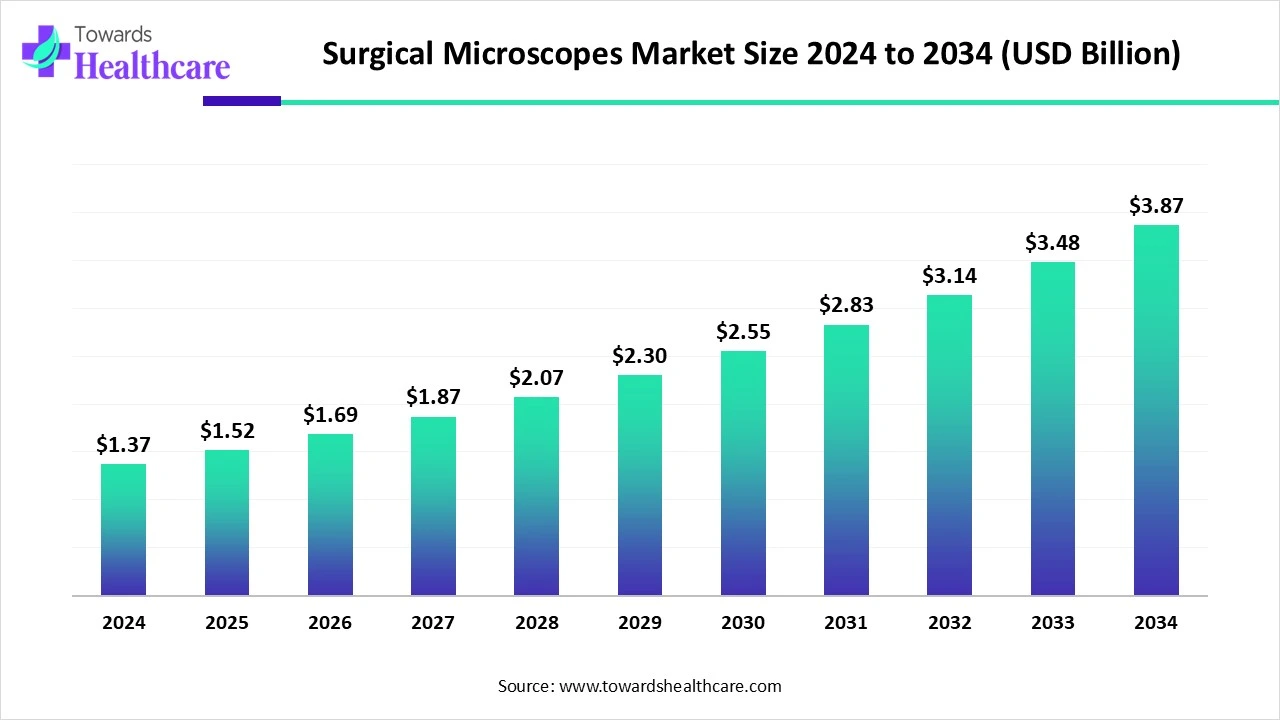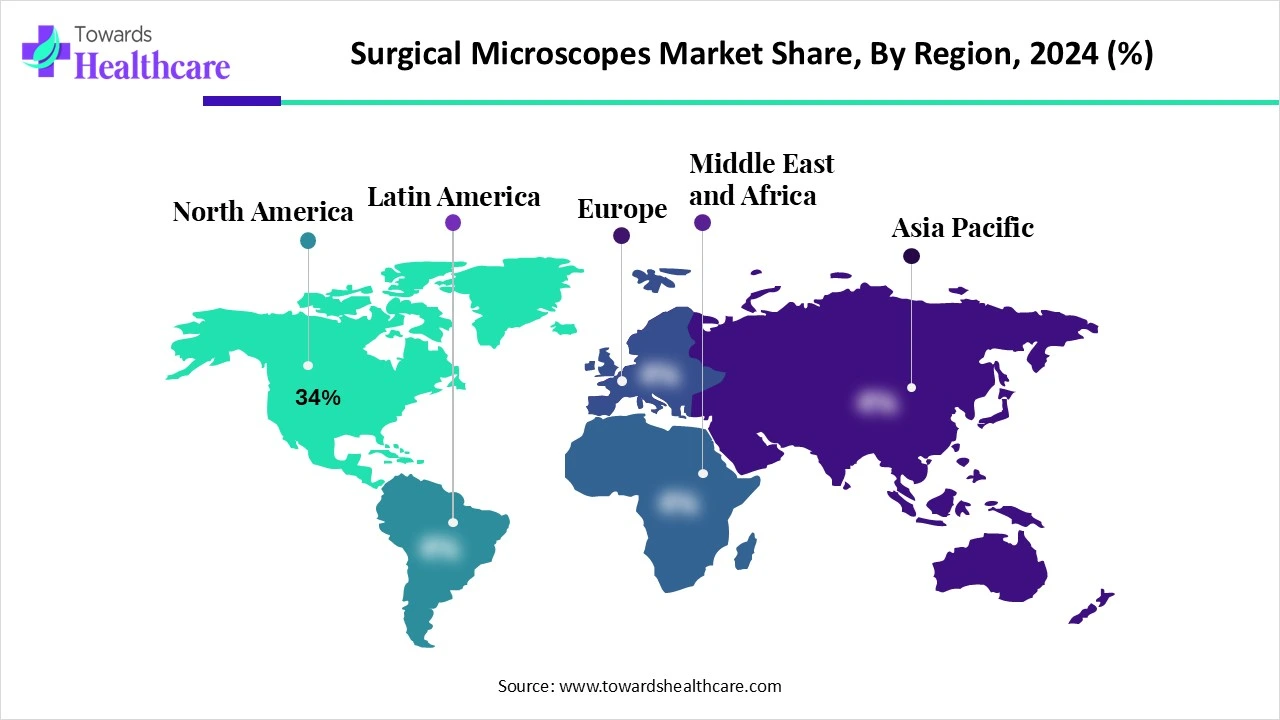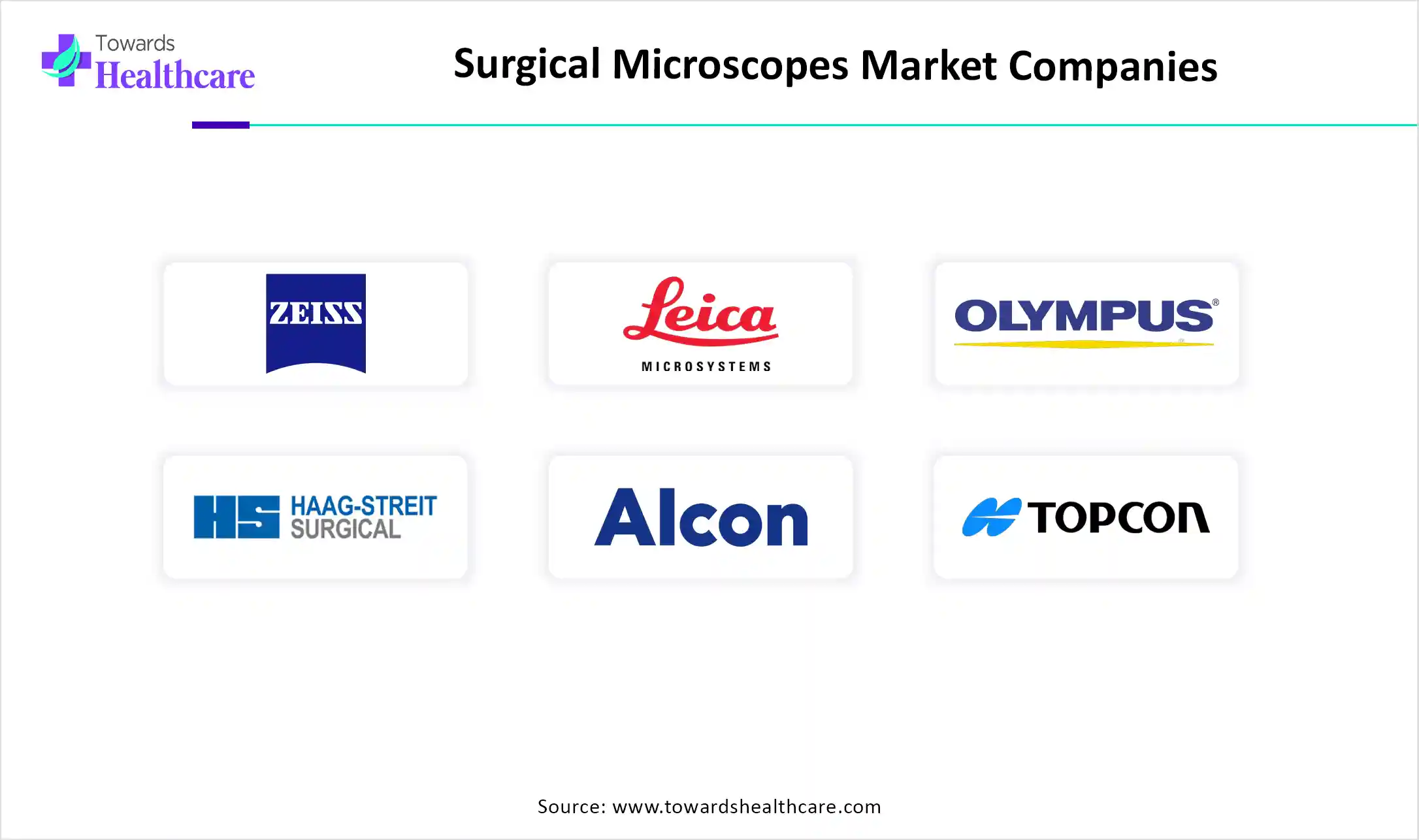January 2026

The global surgical microscope market size was valued at US$ 1.37 billion in 2024 and is projected to grow to US$ 1.52 billion in 2025. Forecasts suggest it will reach approximately US$ 3.87 billion by 2034, registering a CAGR of 10.97% during the period.

The surgical microscope market is witnessing significant growth due to advancements in optical technology, increasing demand for minimally invasive surgeries, and rising adoption across various medical specialties such as neurosurgery, ophthalmology, ENT, and spine surgery. Integration of features like fluorescence imaging, 3D visualization, and robotics is enhancing surgical precision and outcomes. The shift toward application-specific microscopes tailored for different procedures is also fueling innovation.
Additionally, growing healthcare infrastructure, increased government and private investment in medical technology, and rising awareness of surgical accuracy and patient safety are contributing to market expansion globally. Emerging markets and digital integration offer further growth opportunities.
| Table | Scope |
| Market Size in 2025 | USD 1.52 Billion |
| Projected Market Size in 2034 | USD 3.87 Billion |
| CAGR (2025 - 2034) | 10.97% |
| Leading Region | North America Share 34% |
| Market Segmentation | By Application, By End User, By Type, By Modality, By Technology, By Component, By Price Range, By Region |
| Top Key Players | Carl Zeiss Meditec AG, Leica Microsystems (Danaher Corporation), Olympus Corporation, Haag-Streit Surgical (Metall Zug AG), Alcon Inc., Topcon Corporation, ARI Medical Technology Co., Ltd., Seiler Instrument Inc., Takagi Seiko Co., Ltd., Global Surgical Corporation, ATMOS MedizinTechnik GmbH, Chammed Co., Ltd., Mooptics Ltd., Synaptive Medical, Huvitz Co., Ltd., Karl Kaps GmbH & Co. KG, Mitaka Kohki Co., Ltd., Accu-Scope Inc., Lutech Industries Inc., Alltion (Wuzhou) Co., Ltd. |
The Surgical Microscopes Market encompasses the global production, distribution, and application of high-precision optical instruments used to provide magnified visualization of small and complex surgical areas. These microscopes are integral to microsurgical procedures, enhancing accuracy, precision, and surgeon ergonomics across multiple specialties such as neurosurgery, ophthalmology, otolaryngology, dentistry, and plastic/reconstructive surgeries. Typically mounted on a floor stand or ceiling, surgical microscopes integrate optical zoom, LED illumination, digital imaging, and sometimes augmented reality (AR) or robotic assistance. Market growth is driven by rising surgical volume, increasing adoption of minimally invasive procedures, technological advancements, and expanding access to healthcare infrastructure globally.
Microscopes are increasingly tailored to specific fields, such as neurosurgery, ophthalmology, ENT, dental, and others, with specialized optics and visualization modes. A key trend in the surgical microscopes market is the development of application-specific and specialty-focused solutions tailored to different medical fields. Neurosurgical microscopes integrate high magnification, fluorescence imaging (like 5-ALA and ICG), and robotic arms. Ophthalmic units feature red reflex illumination and high-resolution optics, and stereo vision. Dental microscopes emphasize coaxial LED lighting and space-saving mounts. In plastic and reconstructive surgery, systems support ergonomic handling and microvascular work. Spine surgery solutions prioritize deep focus, wide fields of view, and navigation integration. This specialization enhances procedural precision and workflow, driving healthcare settings seeking targeted functionality over general-use models.
There’s a strong push toward microscopes with fluorescence imaging, near-infrared (NIR), optical coherence tomography (OCT), and 3D/4K visualization tools that enhance precision in delicate procedures like neurosurgery and ophthalmology. In July 2025, a team at Duke University's Pratt School of Engineering innovated and revealed the launch of the FiLM-Scope surgical microscope. A surgical scene is captured in 48 multi-perspective images by Film-Scope at the same time. A dense 3D model can be created from these photos by applying a customized reconstruction algorithm, picture courtesy of Duke University’s Clare B. Cook.
With surgeon fatigue in mind, new models deliver ergonomic design, voice-control positioning, and heads-up 3D displays to streamline procedures and operator comfort. In September 2024, Alcon, the world leader in eye care and a company committed to helping people see brilliantly, revealed new developments during the Annual Meeting of the European Society of Cataract and Refractive Surgeons (ESCRS) in Barcelona, September 6–10, 2024. The ARGOS Biometer is what drives the recently released SMARTCataract DX digital planning solution, which powers future Alcon diagnostic technologies, and is intended to boost workflow efficiency for practices. Along with major improvements, NGENUITY 1.5 also adds connectivity features, enabling image-guided 3D cataract surgery with ARGOS Biometer for better visuals. 2,5-11, NGENUITY 1.5, and SMARTCataract DX have been awarded a C Mark and enhance the ecosystem of the Alcon Vision Suite.
AI integration is revolutionizing the surgical microscope market by significantly enhancing precision, efficiency, and clinical outcomes. One of the primary benefits is real-time image analysis, where AI helps surgeons differentiate between healthy and abnormal tissues with greater accuracy during procedures. Advanced autofocus and object-tracking capabilities allow the microscope to automatically adjust focus and follow instruments or anatomical structures, minimizing manual interventions and reducing surgical time.
AI also enables predictive analytics by processing surgical data to anticipate complications, aiding in proactive decision-making. Additionally, AI streamlines workflow by automating tasks such as camera angle adjustments, illumination control, and procedure documentation, allowing surgeons to focus solely on the operation. In training environments, AI-powered surgical microscopes offer interactive simulations and instant feedback, helping medical professionals enhance their skills effectively. These innovations not only improve surgical precision and patient safety but also drive the adoption of intelligent microscopes across diverse surgical specialties, making AI a critical growth driver in the market.
Rising Demand for Minimally Invasive Surgeries & Increased Number of Surgeries
Increasing preference for minimally invasive procedures that require high precision is boosting the adoption of surgical microscopes across various specialties. The global rise in surgical procedures due to aging populations and improved access to healthcare is fueling the need for surgical microscopes. Surgeons and healthcare providers are increasingly adopting tools that ensure better outcomes and reduce complications.
According to the data published by the World Health Organization it has been estimated that in 2024 there were approximately 2.817 million neurosurgical procedures and 1.655 million spine procedures performed in the U.S. Furthermore, the Center for Disease Control and Prevention reports a total of around 51.4 million inpatient surgery procedures across all types in the North America in the year 2024.
Steep Learning Curve & Availability of Alternative Technologies
The key players operating in the market are facing issues due to regulatory and reimbursement challenges as well as alternative technologies, which are estimated to restrict the growth of the market. Operating advanced surgical microscopes requires specialized training. Lack of skilled professionals and training programs can hinder effective utilization. The growing use of endoscopic and robotic-assisted surgeries in some fields reduces the demand for traditional surgical microscopes. Stringent regulatory approvals and uncertain reimbursement policies can delay product launches and discourage investments.
Growth in Ambulatory Surgical Centers (ASCs)
The rising number of ASCs offering outpatient surgeries is fueling demand for compact and affordable surgical microscopes. Integration of digital and connectivity features allows remote surgical assistance and education, expanding use in training and cross-border medical collaboration. According to the data published in April 2025 by the Ambulatory Surgery Center Association (ASCA), based on CMS Medicare-certified data as of March 2025, there are over 6,300 Medicare-certified ASCs in the U.S. IBISWorld reports 6,052 ASC businesses as of January 1, 2024, with a projected increase to 6,348 by January 1, 2025.
The neurosurgery & spine surgery segment dominated the surgical microscopes market due to their high demand for precision, magnification, and enhanced visualization. These procedures involve extremely delicate and complex anatomical structures, requiring surgeons to operate with great accuracy to avoid nerve damage and ensure successful outcomes. Surgical microscopes offer real-time, high-resolution, and 3D views, which are critical during microsurgical techniques in brain and spinal operations. Additionally, the rising incidence of neurological disorders, spinal injuries, and degenerative spine diseases has led to an increased number of surgical interventions. Technological advancements like fluorescence imaging and robotic integration further support the dominance of this segment.
The ophthalmic surgery segment is emerging as the fastest-growing segment in the surgical microscopes market, driven by the increasing prevalence of eye disorders such as cataracts, glaucoma, and retinal diseases. The growing elderly population, who are more prone to vision-related conditions, is significantly boosting the demand for eye surgeries. Surgical microscopes provide exceptional clarity, depth perception, and magnification, critical features for delicate ophthalmic procedures. Additionally, advancements in minimally invasive eye surgeries, coupled with the integration of 3D and digital imaging technologies, are enhancing surgical precision and outcomes. Rising adoption in outpatient and specialty eye clinics further fuels growth in this segment.
The on-caster segment dominates the surgical microscopes market primarily due to its mobility, flexibility, and ease of use in various surgical settings. These microscopes are mounted on a mobile caster wheel base, allowing surgeons to easily maneuver and position the equipment according to procedural needs. This design is particularly beneficial in operating rooms where space optimization and quick repositioning are crucial. On-caster microscopes support multiple specialties like neurosurgery, ENT, ophthalmology, and dentistry, enhancing their utility across departments. Their compatibility with advanced features such as 4K imaging, fluorescence, and co-observation systems further solidifies their preference among healthcare providers, boosting segment dominance.
The ceiling-mounted segment is the fastest-growing in the surgical microscopes market due to its space-saving design and enhanced surgical field accessibility. These systems are ideal for modern operating rooms where floor space is limited and efficiency is crucial. Ceiling-mounted microscopes provide greater stability, wider movement range, and minimal floor clutter, allowing for seamless integration with other surgical equipment. Their ability to accommodate advanced technologies like 3D visualization, digital recording, and navigation systems enhances procedural precision. Increasing adoption in high-end hospitals and specialty centers, where infrastructure supports permanent installations, is also driving rapid growth in this segment over mobile configurations.
The optical microscopes segment holds dominance in the surgical microscopes market due to its long-standing clinical reliability, high-resolution imaging, and cost-effectiveness. These microscopes use advanced optical lenses to provide clear, magnified views essential for precision in delicate surgeries such as neurosurgery, ophthalmology, and ENT. Surgeons prefer optical systems for their real-time imaging capabilities without latency, which is critical during microsurgical procedures. Additionally, optical microscopes are widely available, easy to operate, and require minimal digital infrastructure, making them suitable for both advanced hospitals and mid-sized healthcare facilities. Their continued technological enhancements and integration with basic digital features further strengthen their leading market position.
The AR-integrated systems segment is the fastest-growing in the surgical microscopes market due to its ability to enhance surgical precision, visualization, and decision-making. Augmented Reality (AR) overlays critical anatomical data, navigation cues, and imaging insights directly into the surgeon’s field of view, improving intraoperative accuracy without interrupting workflow. This technology is especially valuable in complex surgeries such as neurosurgery and spine surgery, where millimeter-level precision is essential. Surgeons benefit from real-time guidance and better depth perception, which reduces errors and shortens operative times. The growing adoption of smart operating rooms and increased investment in medical innovation are accelerating the demand for AR-integrated systems.
The microscope lens segment is the dominant component in the surgical microscopes market due to its critical role in delivering high-resolution, magnified visualization essential for precision surgery. High-quality lenses ensure clarity, depth perception, and accurate focus, enabling surgeons to perform intricate procedures with confidence and safety. These lenses are fundamental across all surgical specialties, including neurosurgery, ophthalmology, and ENT, making them indispensable in any microscope setup. Continuous advancements in optical lens materials, coatings, and magnification technology have further enhanced their performance and durability. The lens’s central function in determining image quality and surgical outcomes secures its leading position in the market.
The camera system segment is the fastest-growing in the surgical microscope market due to the rising demand for real-time imaging, surgical documentation, and educational purposes. Modern camera systems allow high-definition video capture and live streaming of surgeries, enhancing collaboration among surgical teams and supporting remote consultations. These systems are particularly valuable for training medical professionals and for use in teaching hospitals. Integration with digital platforms, augmented reality, and 3D visualization further boosts their utility in complex procedures. As digital surgery and telemedicine continue to expand, the adoption of advanced camera systems in surgical microscopes is accelerating significantly across global healthcare settings.

North America dominates the surgical microscopes market share by 34% in 2024, due to its advanced healthcare infrastructure, strong presence of leading medical device manufacturers, and high adoption of technologically advanced surgical tools. The region sees significant investments in healthcare innovation, particularly in neurosurgery, ophthalmology, and ENT procedures, where surgical microscopes are widely used. Favourable reimbursement policies, a high volume of surgical procedures, and strong demand for minimally invasive techniques further support market dominance. The presence of top-tier hospitals and research institutions, along with a well-established distribution network, accelerates the uptake of innovative products. Additionally, early adoption of digital and AR-integrated systems fuels continued market leadership in the region.
The U.S. leads the regional market due to its world-class healthcare system, high surgical volumes, and rapid adoption of advanced technologies like AR, 3D imaging, and robotics. Government funding, strong academic research presence, and collaborations between hospitals and medtech companies further fuel innovation. A high number of specialized surgeons and training centers also contributes to the strong demand for surgical microscopes.
Canada shows steady growth supported by public healthcare investments and increasing adoption of minimally invasive procedures. The country’s growing emphasis on upgrading surgical equipment in hospitals and expanding neurosurgical and ophthalmic capabilities is boosting the need for high-performance surgical microscopes. Canada’s regulatory clarity and focus on digital health integration also support the market expansion.
The Asia-Pacific region is the fastest-growing in the surgical microscopes market due to rising healthcare infrastructure development, increasing medical tourism, and a growing demand for advanced surgical technologies. Countries such as China, India, Japan, and South Korea are witnessing a surge in complex surgical procedures, especially in neurosurgery, ophthalmology, and ENT.
The expanding population and rising incidences of chronic diseases are driving the need for precision surgeries, thereby boosting microscope adoption. Government initiatives to modernize hospitals, along with increased foreign investments in healthcare technology, are accelerating growth. Additionally, the cost-effectiveness of surgeries in the region compared to Western nations attracts international patients, further increasing surgical volumes. Local manufacturing capabilities and rising awareness among surgeons about enhanced visualization tools are further propelling market expansion.
India is witnessing rapid growth due to its expanding hospital infrastructure and increasing volume of neurosurgeries and ophthalmic procedures. Government initiatives like Ayushman Bharat are enhancing access to advanced surgical care. Several private hospitals are investing in state-of-the-art surgical equipment, including AR-integrated microscopes. India's growing medical tourism sector, offering affordable surgeries, further boosts the demand.
China’s market growth is driven by strong government funding in healthcare modernization and a surge in minimally invasive surgeries. Major domestic manufacturers are entering the surgical microscope space, improving accessibility. Leading hospitals are adopting advanced systems for brain and spinal surgeries, supporting technological growth.
Japan’s growth is fuelled by its aging population and high demand for precision in ophthalmic and ENT surgeries. Japanese companies are pioneering advanced surgical microscopes, and hospitals are early adopters of AR, 3D, and robotic-integrated systems, ensuring strong market performance.
Europe is growing at a notable rate in the surgical microscopes market due to its well-established healthcare infrastructure, increasing demand for minimally invasive surgeries, and strong emphasis on research and innovation. Countries like Germany, France, and the UK are major contributors, with high surgical volumes in neurosurgery and ophthalmology.
Europe is also home to leading surgical microscope manufacturers like Leica Microsystems (Germany) and Carl Zeiss (Germany), which continuously innovate and launch advanced products. For instance, Carl Zeiss introduced its ARveo 8 microscope platform, designed for neurosurgical precision with integrated digital visualization. Additionally, the EU’s support for digital health and medical device innovation encourages hospital upgrades. Collaborations between hospitals and research institutes for clinical trials and the integration of AR and AI technologies further enhance the region’s position. The growing elderly population across Europe also contributes to higher demand for eye and spine surgeries, accelerating microscope adoption.

In July 2025, Maxwell Liu, Head of Sales & Services of ZEISS MED China, stated that the PENTERO 800 S provides a higher magnification, deeper depth of field, and resolution, combined with 4K 3D digital technology. This will help surgeons in extending optical capabilities at every step of the surgical procedure.
By Application
By End User
By Type
By Modality
By Technology
By Component
By Price Range
By Region
January 2026
January 2026
January 2026
December 2025